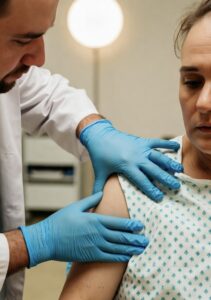Nursing management
- Health promotion
- Teach patient to identify and avoid known triggers
- Use dust covers
- Use scarves or masks for cold air
- Avoid aspirin and NSAIDs
- Prompt diagnosis and treatment of upper respiratory infections and sinusitis may prevent asthma exacerbation
- Fluid intake of 2 to 3 L every day
- Good nutrition
- Adequate rest
- Teach patient to identify and avoid known triggers
- Nursing Assessment
- Subjective Data
- Important Health Information
- Past health history: Allergic rhinitis, sinusitis, or skin allergies.
- Previous asthma attack and hospitalization or intubation. Symptoms worsened by triggers in the environment. Gastroesophageal reflux disease (GERD). Occupational exposure to chemical irritants (e.g., paints, dust)
- Medications: Adherence to medication, inhaler technique. Use of antibiotics. Pattern and amount of short-acting β2 –adrenergic agonist used per week. Medications that may precipitate an attack in susceptible asthmatics such as aspirin, nonsteroidal anti-inflammatory drugs, β-adrenergic blockers
- Functional Health Patterns
- Health perception–health management: Family history of allergies or asthma. Recent upper respiratory tract or sinus infection
- Activity-exercise: Fatigue, decreased or absent exercise tolerance. Dyspnea, cough (especially at night), productive cough with yellow or green sputum or sticky sputum. Chest tightness, feelings of suffocation, air hunger, talking in short sentences or words or phrases, sitting upright to breathe
- Sleep-rest: Awakened from sleep because of cough or breathing difficulties, insomnia
- Coping–stress tolerance: Emotional distress, stress in work environment
- or home
- Important Health Information
- Objective Data
- General
- Restlessness or exhaustion, confusion, upright or forward-leaning body position
- Integumentary
- Diaphoresis, cyanosis (circumoral, nail bed), eczema
- Respiratory
- Nasal discharge, nasal polyps, mucosal swelling. Crackles, diminished or absent breath sounds, and wheezes on auscultation. Hyperresonance on percussion. Sputum (thick, white, tenacious), Increased work of breathing with use of accessory muscles. Intercostal and supraclavicular retractions. Tachypnea with hyperventilation. Prolonged expiration
- Cardiovascular
- Tachycardia, pulsus paradoxus, jugular venous distention, hypertension or hypotension, premature ventricular contractions
- Possible Diagnostic Findings
- Abnormal ABGs during attacks,
- Decreased O2 saturation, serum and sputum eosinophilia
- Increased serum IgE, positive skin tests for allergens, chest x-ray demonstrating hyperinflation with attacks
- Abnormal pulmonary function tests showing decreased flow rates; FVC, FEV1, PEFR, and FEV1/FVC ratio that improve between attacks and with bronchodilators
- General
- Subjective Data




